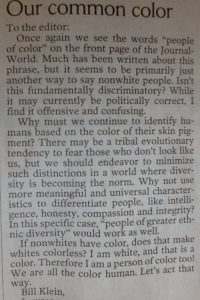There’s an old joke that the hardest problem in programming is naming things. We rarely talk about why. I suggest it’s because naming things is the crucial point of contact between our two audiences. We write code for both people and machines. Machines don’t care about naming except that it be consistent. People, on the other hand, want words to signify to realities outside the code itself. The next programmer to read my code is my audience too, and I need my word choices to signify to their nuanced and lived understanding of the problem we are trying to solve with the code. This is one example of why I have often said that computers are easy and people are hard.
I’ve spent the last five years of my professional life in and around governments. One of the results of that time has been a lot of thinking about the words my colleagues and I use to describe the work we do. So far, the least bad words we’ve found are “Digital Service.” We are not satisfied with those words, because they still confuse some people that we work with. Still, they are accurate, and until we find something better, we’ll probably stick with them. Here’s how I define them.
Digital Service (initial cap, singular, not services) is a specific form of public (government) service designed to bring people with skills and experience with modern information technology from the private sector into the public sector for limited lengths of time. The two goals are modernizing the way government services are designed and delivered, and exposing a particular talent pool to the experience of public service. Digital Service is an idea similar to the Peace Corps or AmeriCorps.
I rigorously avoid the phrase “digital services” because it confuses folks who, when they hear the words “digital” or “technology” immediately place it in the mental category of the nerds/geeks down in the basement who you call when your printer won’t print or your computer won’t start. That’s digital services. Some of those nerds may leave the basement and join a Digital Service and day-to-day use the same skills, but their efforts are directed in a different strategic way.
Because Digital Service is not really about technology. It’s about changing organizational process.
The Digital Service mindset says: governments should begin with understanding what their constituents need and want, and deliver those services in the most constituent-friendly way possible. If constituents needed and wanted tax forms delivered to them on stone tablets, then the Digital Service approach would be to (a) identify that need and (b) work with other public servants to deliver it in the best way that they can. The word “Digital” describes the field in which these public servants have honed their skills, not necessarily the means by which they serve.
Now of course it just so happens that most constituents prefer mobile electronic devices over stone tablets, so it’s quite convenient that those same people committed to meeting constituent needs also happen to be fluent in digital technology.
The problems we encounter in government are the same human problems we encounter everywhere, only more so. The difference is that government impact is at such a bigger scale and with an institutional memory and inertia much greater than other organizations. Because of that bigger scale, there is a lot of fear in government. Government is full of risk averse people, just like other large organizations. Large organizations, in fact, attract risk averse employees, because they are stable places of employment. The consequence of all that risk aversion, however, is that things rarely change. Digital technology changes rapidly in the private sector. The public sector, resistant to change, full of fear, is slow to change. And yet government constituents need and want services built with modern technologies, which governments are very slow to adopt. That tension between what government is suited to provide and what its constituents want provided has led to debacles and lots of time/money wasted.
Enter Digital Service. Why is it that people who have spent time in the private sector working with modern technologies would have skills in managing large institutional change? The truth is that we don’t. What we have is experience working in ways that allow for managing risk. The biggest systemic problems we have encountered in government are not about technology per se. They include:
- acquiring the necessary paperwork to launch a new website (ATO)
- hiring people
- how the government buys technology (procurement)
- managing custom software projects
None of those are technical problems. They are all risk management problems. Like the old joke about naming things, we address them with Digital Service because Recovery From Risk Avoidance Service is a mouthful.
